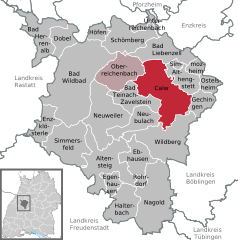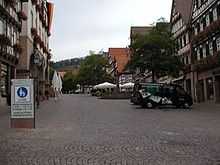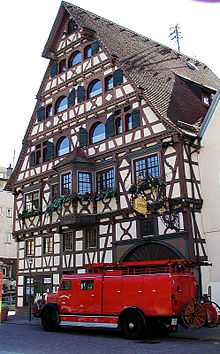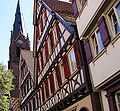Calw
| Calw | ||
|---|---|---|
 | ||
| ||
 Calw | ||
Location of Calw within Calw district 
 | ||
| Coordinates: 48°43′0″N 8°44′0″E / 48.71667°N 8.73333°ECoordinates: 48°43′0″N 8°44′0″E / 48.71667°N 8.73333°E | ||
| Country | Germany | |
| State | ||
| Admin. region | Karlsruhe | |
| District | Calw | |
| Government | ||
| • Mayor | Ralf Eggert | |
| Area | ||
| • Total | 59.88 km2 (23.12 sq mi) | |
| Population (2012-12-31)[1] | ||
| • Total | 22,275 | |
| • Density | 370/km2 (960/sq mi) | |
| Time zone | CET/CEST (UTC+1/+2) | |
| Postal codes | 75351-75365 | |
| Dialling codes | 07051, 07053 | |
| Vehicle registration | CW | |
Calw (German pronunciation: [ˈkalf]; locally [kʰalp]) is a town in the middle of Baden-Württemberg in the south of Germany, capital of the district Calw. It is located in the northern Black Forest and is approximately 18 kilometers south of Pforzheim and 33 kilometers west of Stuttgart.
History
Calw was first mentioned in records in 1075. In the 11th century the town grew around the older castle of the Grafen (Earls) of Calw. In the Middle Ages Calw was an important commercial town especially for the trade of cloth and leather. In 1345 Calw became part of Württemberg and by the 16th century had become the summer residence of the Duke of Württemberg. In the 18th century Calw flourished from the lumber trade and rafting of timber on the river Nagold.
Due to her romantic relationship with a Polish guest worker, seventeen year-old Calw resident Erna Brehm was publicly shaved bald in the town's market square in August 1941. She served eight months in jail in Calw and Stuttgart for violating Nazi Rassenschande ("racial shame") laws before being deported to Ravensbrück concentration camp. She was released on 1 April 1944 because she was in such poor health that she was no longer able to work. She was extremely underweight (reportedly only 34.5 kilograms or 76 pounds) and died on 19 August 1951 at the age of twenty-seven.[2]
During World War II, a small subcamp of Natzweiler-Struthof concentration camp, where parts for aircraft where assembled by female forced laborers, was located here.[3] The most prominent resident of Calw was the author and Nobel prize winner Hermann Hesse.
The district reform of 1 January 1973 gave Calw its current size. It became a part of the newly founded Northern Black Forest Region, which itself was assigned to the administrative region of Karlsruhe. On 1 January 1975 Calw was combined with the municipalities of Altburg, Hirsau and Stammheim into the town of Calw-Hirsau. On 1 January 1976 it was renamed as Calw.
Politics
Municipal council
Since the municipal elections of 7 June 2009 the municipal council of Calw has had a total of thirty members (previously there were only twenty-seven). Furthermore, the Lord Mayor (in German "Oberbürgermeister") acts as the chairperson of the council. The result of the last election was:
| Party | Percentage of Votes | + / - | Seats | + / - |
|---|---|---|---|---|
| Free Voters | 35.7% | - 3.6 | 11 | ± 0 |
| Christian Democratic Union | 23.4% | - 1.2 | 7 | ± 0 |
| Social Democratic Party | 14.0% | - 2.0 | 4 | ± 0 |
| Free Democratic Party / Green Party | 19.5% | + 2.6 | 6 | + 2 |
| Neue Liste Calw | 7.5% | + 3.9 | 2 | + 1 |
Mayor
By the 15th century Calw had an electoral system that chose a new mayor every two years. Proof exists for a council as far back as 1453.
Mayors and Lord Mayors
|
|
Important facts and figures about Calw
- Outlying districts: Alzenberg, Wimberg, Heumaden
- Town districts: Altburg, Hirsau, Stammheim, Holzbronn
- Labor force: Compulsorily insured employees 8,014. Of these:
- Manufacturing industries: 2,763
- Service industries: 5,251
- Waterways - Nagold river, Tälesbach, Ziegelbach, Wurstbrunnenbach, Schießbach, Schlittenbach, Schweinbach
- Base of the Kommando Spezialkräfte (KSK) (Special Forces Command)
Tourism and importance
Calw is heavily pedestrianised, and has begun catering for the tourist trade with numerous shops, restaurants, bistros and ice-cream parlours being opened. This growth has allowed Calw to be considered a large town at the centre of its district.
Famous residents
- Hermann Hesse, author
- Peter Lehmann, social scientist, publisher, freelance activist in humanistic anti-psychiatry, honorary doctor of the Aristotle University of Thessaloniki, Greece, Knight of the Order of Merit of the Federal Republic of Germany
- Johannes Valentinus Andreae, clergyman
- Rudolf Schlichter, painter
- Heinz-Wolfgang Schnaufer Knights Cross & Diamonds. Highest scoring luftwaffe night fighter pilot of World War II.
- Marcel Goc, NHL player who currently plays for the Florida Panthers.
- Sascha Goc, NHL player who played for the New Jersey Devils and the Tampa Bay Lightning.
Twinnings
References
- ↑ [Statistisches Bundesamt – Gemeinden in Deutschland mit Bevölkerung am 31.12.2012 (XLS-Datei; 4,0 MB) (Einwohnerzahlen auf Grundlage des Zensus 2011) "Gemeinden in Deutschland mit Bevölkerung am 31.12.2012"]. Statistisches Bundesamt (in German). 12 November 2013.
- ↑ http://www.zeit.de/1985/06/verbotene-liebe/komplettansicht
- ↑ Concentration Camp Listing
| |||||||







